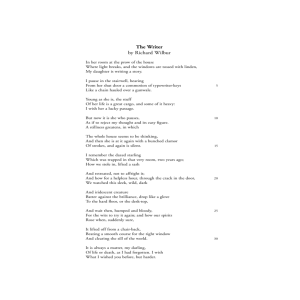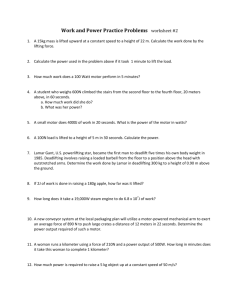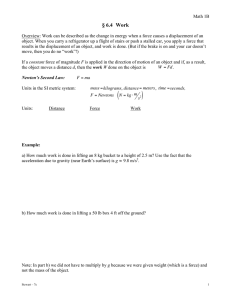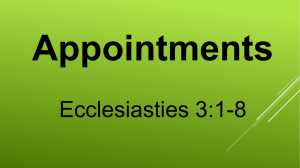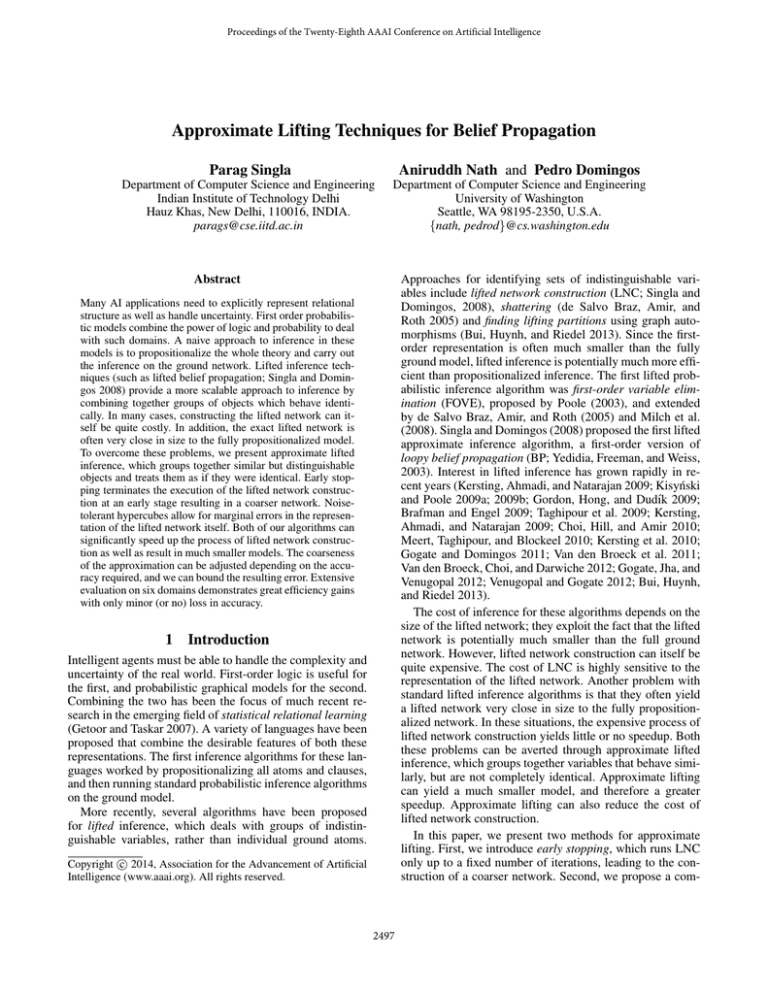
Proceedings of the Twenty-Eighth AAAI Conference on Artificial Intelligence
Approximate Lifting Techniques for Belief Propagation
Parag Singla
Aniruddh Nath and Pedro Domingos
Department of Computer Science and Engineering
Indian Institute of Technology Delhi
Hauz Khas, New Delhi, 110016, INDIA.
parags@cse.iitd.ac.in
Department of Computer Science and Engineering
University of Washington
Seattle, WA 98195-2350, U.S.A.
{nath, pedrod}@cs.washington.edu
Abstract
Approaches for identifying sets of indistinguishable variables include lifted network construction (LNC; Singla and
Domingos, 2008), shattering (de Salvo Braz, Amir, and
Roth 2005) and finding lifting partitions using graph automorphisms (Bui, Huynh, and Riedel 2013). Since the firstorder representation is often much smaller than the fully
ground model, lifted inference is potentially much more efficient than propositionalized inference. The first lifted probabilistic inference algorithm was first-order variable elimination (FOVE), proposed by Poole (2003), and extended
by de Salvo Braz, Amir, and Roth (2005) and Milch et al.
(2008). Singla and Domingos (2008) proposed the first lifted
approximate inference algorithm, a first-order version of
loopy belief propagation (BP; Yedidia, Freeman, and Weiss,
2003). Interest in lifted inference has grown rapidly in recent years (Kersting, Ahmadi, and Natarajan 2009; Kisyński
and Poole 2009a; 2009b; Gordon, Hong, and Dudı́k 2009;
Brafman and Engel 2009; Taghipour et al. 2009; Kersting,
Ahmadi, and Natarajan 2009; Choi, Hill, and Amir 2010;
Meert, Taghipour, and Blockeel 2010; Kersting et al. 2010;
Gogate and Domingos 2011; Van den Broeck et al. 2011;
Van den Broeck, Choi, and Darwiche 2012; Gogate, Jha, and
Venugopal 2012; Venugopal and Gogate 2012; Bui, Huynh,
and Riedel 2013).
The cost of inference for these algorithms depends on the
size of the lifted network; they exploit the fact that the lifted
network is potentially much smaller than the full ground
network. However, lifted network construction can itself be
quite expensive. The cost of LNC is highly sensitive to the
representation of the lifted network. Another problem with
standard lifted inference algorithms is that they often yield
a lifted network very close in size to the fully propositionalized network. In these situations, the expensive process of
lifted network construction yields little or no speedup. Both
these problems can be averted through approximate lifted
inference, which groups together variables that behave similarly, but are not completely identical. Approximate lifting
can yield a much smaller model, and therefore a greater
speedup. Approximate lifting can also reduce the cost of
lifted network construction.
In this paper, we present two methods for approximate
lifting. First, we introduce early stopping, which runs LNC
only up to a fixed number of iterations, leading to the construction of a coarser network. Second, we propose a com-
Many AI applications need to explicitly represent relational
structure as well as handle uncertainty. First order probabilistic models combine the power of logic and probability to deal
with such domains. A naive approach to inference in these
models is to propositionalize the whole theory and carry out
the inference on the ground network. Lifted inference techniques (such as lifted belief propagation; Singla and Domingos 2008) provide a more scalable approach to inference by
combining together groups of objects which behave identically. In many cases, constructing the lifted network can itself be quite costly. In addition, the exact lifted network is
often very close in size to the fully propositionalized model.
To overcome these problems, we present approximate lifted
inference, which groups together similar but distinguishable
objects and treats them as if they were identical. Early stopping terminates the execution of the lifted network construction at an early stage resulting in a coarser network. Noisetolerant hypercubes allow for marginal errors in the representation of the lifted network itself. Both of our algorithms can
significantly speed up the process of lifted network construction as well as result in much smaller models. The coarseness
of the approximation can be adjusted depending on the accuracy required, and we can bound the resulting error. Extensive
evaluation on six domains demonstrates great efficiency gains
with only minor (or no) loss in accuracy.
1
Introduction
Intelligent agents must be able to handle the complexity and
uncertainty of the real world. First-order logic is useful for
the first, and probabilistic graphical models for the second.
Combining the two has been the focus of much recent research in the emerging field of statistical relational learning
(Getoor and Taskar 2007). A variety of languages have been
proposed that combine the desirable features of both these
representations. The first inference algorithms for these languages worked by propositionalizing all atoms and clauses,
and then running standard probabilistic inference algorithms
on the ground model.
More recently, several algorithms have been proposed
for lifted inference, which deals with groups of indistinguishable variables, rather than individual ground atoms.
c 2014, Association for the Advancement of Artificial
Copyright Intelligence (www.aaai.org). All rights reserved.
2497
later. Our early stopping can be viewed as a form of piecewise decomposition up to depth d, although this decomposition may not in general result in a tree. Further, in our case,
the decomposition is only used for lifting (inference still retains all the connections) unlike the piecewise inference of
Ahmadi et al. (2013) where certain connections might be
lost leading to larger deviations from the original network.
Exploring the exact connection between the two approaches
and making an empirical comparison is an item for future
work.
pact hypercube representation for the lifted network. This
forms the basis for approximate lifting by allowing for a
threshold noise in hypercubes while constructing the lifted
network. We describe a bound on the error for a given level
of approximation. We perform an extensive evaluation of
both exact and approximate lifted inference; the results show
that our techniques greatly reduce the cost of inference without significantly affecting the quality of the solutions. Like
Singla and Domingos (2008), we use Markov logic as the
representation language, but our methods are applicable to
many other first-order probabilistic representations.
2
3
Related Work
Graphical Models
Graphical models compactly represent the joint distribution
of a set of variables X = (X1 , X2 , . . . , Xn ) Q∈ X as a
product of factors (Pearl 1988), P (X = x) = Z1 k fk (xk ),
where each factor fk is a non-negative function of a subset of the variables xk , and Z is a normalization constant.
Under appropriate restrictions, the model is a Bayesian network and Z = 1. A Markov network or Markov random field can have arbitrary factors. Graphical models
can alsoPbe represented in log-linear form, P (X = x) =
1
i wi gi (x)), where the features gi (x) are arbitrary
Z exp (
functions of the state. A factor graph (Kschischang, Frey,
and Loeliger 2001) is a bipartite undirected graph with a
node for each variable and factor in the model. Variables are
connected to the factors they appear in.
A key inference task in graphical models is computing the
marginal probabilities of some variables (the query) given
the values of some others (the evidence). This problem is
#P-complete, but can be solved approximately using loopy
belief propagation, which works by passing messages from
variable nodes to factor nodes and vice versa. The message
from a variable x to a factor f at iteration i + 1 is:
Y
µxf,i+1 (a) =
µhx,i (a)
De Salvo Braz et al. (2009) proposed a form of approximate lifting that combines lifted belief propagation with box
propagation (Mooij and Kappen 2008). To our knowledge,
this algorithm has not been implemented and evaluated, and
a detailed description has not yet been published. Sen, Deshpande, and Getoor (2009) proposed a lifting algorithm based
on the notion of bisimulation, and an approximate variant of
it using mini-buckets (Dechter and Rish 2003). Their technique is very effective on some domains, but it is not clear
how scalable it is on more general domains, such as those
considered in this paper (including Cora entity resolution
task where it fails to provide a speed-up).
Kersting et al. (2010) proposed an algorithm called informed lifted belief propagation (iLBP) (Kersting et al.
2010), which interleaves the LNC steps and the BP steps and
avoids creating the exact lifted network when BP converges
in fewer iterations than LNC. iLBP can be further sped up by
combining it with the approximation schemes and compact
representations presented in this paper; this is a direction for
future work.
Gogate and Domingos (2011) introduce a sampling version of their lifted weighted model counting approach which
does approximate inference, but only over exact lifted models. Van den Broeck, Choi, and Darwiche (2012) present a
technique for approximate lifting by first relaxing some of
the constraints and then compensating for the relaxations.
The set of relaxed constraints determines the quality of the
approximation. Their approach provides a spectrum of solutions with lifted BP (fastest) on one extreme and lifted exact
inference (most accurate) on the other. They report experiments over relatively small-sized domains, and it is not clear
how well their approach would scale. On the other hand, our
lifted approximations further relax the lifted network constructed by BP to make lifting scalable to much larger real
world domains of practical interest.
Van den Broeck and Darwiche (2013) explore the possibility of lifted inference by approximating evidence using
a low rank Boolean matrix factorization. The experimental
evaluation is presented over a limited set of domains. Our
noisy hypercube approximation can be seen as an instance
of over-symmetric evidence approximation (Van den Broeck
and Darwiche 2013) which we show works well in practice
for a variety of real world domains.
Ahmadi et al. (2013) present an approach for breaking the
network into tree-structured pieces over which (lifted) inference can be performed independently and results combined
h∈nb(x)\{f }
where nb(x) is the set of factors it appears in. (Evidence
variables send 1 for the evidence value, and 0 for others.)
Typically, µf x,1 = 1. The message from a factor to a variable is:
X
Y
f (xa )
µf x,i (a) =
µyf,i (yxa )
xa
y∈nb(f )\{x}
where nb(f ) are the arguments of f ; xa is an assignment of
values to the variables in nb(f ), with x set to a; yxa is the
value of y in xa . The (unnormalized)
marginal of variable
Q
x is given by Mx,i (a) = h∈nb(x) µhx,i (a). In general, belief propagation is not guaranteed to converge, and it may
converge to an incorrect result, but in practice it often approximates the true probabilities well.
4
Lifted Belief Propagation
Markov logic (Richardson and Domingos 2006) is a probabilistic extension of first-order logic. Formulas in first-order
logic are constructed from logical connectives, predicates,
constants, variables and functions. A grounding of a predicate (or ground atom) is a replacement of all its arguments
2498
Algorithm 1 LNC(MLN M, constants C, evidence E)
by constants (or, more generally, ground terms). A grounding of a formula is a replacement of all its variables by constants. A possible world is an assignment of truth values to
all possible groundings of predicates.
A Markov logic network (MLN) is a set of weighted firstorder formulas. Together with a set of constants, it defines
a Markov network with one node per ground atom and one
feature per ground formula. The weight of a feature is the
weight of the first-order formula that originated it. The probability distribution over possible worlds x specified
by the
P
MLN and constants is thus P (x) = Z1 exp( i wi ni (x)),
where wi is the weight of the ith formula and ni (x) its number of true groundings in x.
Inference in an MLN can be carried out by creating the
corresponding ground Markov network and applying standard BP to it. A more efficient alternative is lifted belief
propagation, which avoids grounding the network as much
as possible (Singla and Domingos 2008). Lifted BP (LBP)
constructs a lifted network composed of supernodes and superfeatures, and and applies BP to it. It is guaranteed to give
the exact same results as running BP on the ground network.
A supernode is a set of atoms that send and receive exactly
the same messages throughout BP, and a superfeature is a set
of ground clauses that send and receive the same messages.
A supernode and a superfeature are connected iff some atom
in the supernode occurs in some ground clause in the superfeature.
The lifted network is constructed by starting with an
extremely coarse network, and then refining it essentially
by simulating BP and keeping track of which nodes send
the same messages (Algorithm 1). The count n(s, F ) is
the number of identical messages atom s would receive in
message passing from the features in F . Belief propagation
must be altered slightly to take these counts into account.
Since all the atoms in a supernode have the same counts,
we can set n(X, F ) = n(s, F ), where s is an arbitrary atom
in X. The message µ
F X (a) from F to X remains the same
P
Q
as before:
Xa f (Xa )
Y ∈nb(F )\{X} µY F,i (yXa ) .
The message µQ
from X to F becomes
XF (a)
µF X,i (a)n(X,F )−1 H∈nb(X)\{F } µHX,i (a)n(X,H) . The
Q
marginal becomes H∈nb(X) µHX,i (x)n(X,H) .
An important question remains: how to represent supernodes and superfeatures. Although this does not affect the
space or time cost of inference on the lifted network, it can
greatly affect the cost of constructing the lifted network.
The choice of particular representation can also pave the
way for an approximate construction of the lifted network
(thereby saving computational cost). In general, finding the
most compact representation for supernodes and superfeatures is an intractable problem.
Singla and Domingos (2008) considered two representations. The simplest option is to represent each supernode
or superfeature extensionally as a set of tuples (i.e., a relation), in which case joins and projections reduce to standard
database operations. However, in this case the cost of constructing the lifted network is similar to the cost of constructing the full ground network, and can easily become the bot-
for all predicates P do
for all truth values v do
Form a supernode with all groundings of P
with truth value v
end for
end for
repeat
for all clauses C involving P1 , . . . , Pk do
for all tuples of supernodes (X1 , . . . , Xk ),
where Xi is a Pi supernode do
Form a superfeature by joining X1 , . . . , Xk
end for
end for
for all supernodes X of predicate P do
for all superfeatures F it is connected to do
for all tuples s in X do
n(s, F ) ← num of F ’s tuples that project to s
end for
end for
Form a new supernode from each set of tuples in X with
same n(s, F ) counts for all F
end for
until convergence
return Lifted network L, containing all current supernodes
and superfeatures
tleneck. Another option is to use a more compact representation using a constraint language, as done by Poole (2003)
and de Salvo Braz et al. (2005; 2006). A simple such constraint language allows for equality/inequality constraints to
be represented explicitly; we will refer to it as resolution-like
representation. Taghipour et al. (2012) propose a framework
for representing arbitrary constraints in lifted variable elimination. They propose a constraint language similar to our
hypercube representation for lifted BP (Section 5).
5
Approximate Lifting
Early Stopping
The LNC algorithm described in section 4 is guaranteed
to create the minimal lifted network (Singla and Domingos 2008). Running BP on this network is equivalent to BP
on the fully propositionalized network, but potentially much
faster. However, the minimal exact lifted network is often
very close in size to the propositionalized network. Running
LNC to convergence may also be prohibitively expensive.
Both of these problems can be alleviated with approximate
lifting. The simplest way to make LNC approximate is to
terminate LNC after some fixed number of iterations k, thus
creating k lifted networks at increasing levels of fineness
(Nath and Domingos 2010). No new supernodes are created
in the final iteration. Instead, we simply average the superfeature counts n(X, F ) for supernode X over all atoms s in
X.
Each resulting supernode contains nodes that send and receive the same messages during the first k steps of BP. By
stopping LNC after k iterations, we are in effect pretending
that nodes with identical behavior up to this point will continue to behave identically. This is a reasonable approxima-
2499
tion, since for two nodes to be placed in the same supernode,
all evidence and network topology within a distance of k − 1
links must be identical. If the nodes would have been separated in exact LNC, this would have been a result of some
difference at a distance greater than k − 1. In BP, the effects of evidence typically die down within a short distance.
Therefore, two nodes with similar neighborhoods would be
expected to behave similarly for the duration of BP.
where
log ζx,n
=
X
log νf x,n
f ∈nb(x)
νf x,1
log νxf,i+1
= d(f )2
X
=
log νhx,i + log δxf,i+1
h∈nb(x)\{f }
The error induced by stopping after k iterations can be
bounded by calculating the additional error introduced at
each BP step as a result of the approximation. To do this,
we perform one additional iteration of LNC (for a total of
k + 1), and compute the difference between the messages
calculated at the level k and level k +1 at each BP step (after
initializing the messages at level k +1 from those at level k).
To see why this captures the new error in step i of BP, consider a fully ground network initialized with the messages
at level k of the lifted network. Run one step of BP on the
ground network, passing messages from variables to factors
and vice versa. The resulting messages on the ground network are identical to those yielded by initializing the messages at level k + 1 the same way, and running a single step
of BP. In other words, computations on level k + 1 tell us
what the correct messages in the next step should be, assuming the current messages are correct. (In general, the current
messages are actually incorrect, but the errors have already
been accounted for.) This allows us to compute the error introduced in the current iteration, and incorporate it into the
bound.
log νf x,i
=
log εf x,i
=
log
d(f )2 εf x,i + 1
d(f )2 + εf x,i
X
log νyf,i
y∈nb(f )\{x}
s
δxf,i
=
sup
xs ,ys
d(f )
=
sup
µ̂xf,i (xs ) µ̃xf,i (ys )
µ̃xf,i (xs ) µ̂xf,i (ys )
p
f (x)/f (y)
x,y
Proof. d(f ) is the dynamic range of function f , as defined
in Ihler, Fisher, and Willsky (2005). Since we can calculate µ̂xf,i (xs ) and µ̃xf,i (xs ), the dynamic range of the error
function can be calculated as follows:
s
µ̂xf,i (xs ) µ̃xf,i (ys )
d(ẽxf,i ) = sup
= δxf,i
µ̃xf,i (xs ) µ̂xf,i (ys )
xs ,ys
Using the same logic as Theorem 15 of Ihler, Fisher, and
Willsky (2005), for any fixed point beliefs {Mx } found by
ground BP, after n ≥ 1 steps of BP at level k resulting in
beliefs {M̂x,n }1
X
log d(Mx /M̂x,n ) ≤
log νf x,n = log ζx,n
Let snk (x) and sfk (f ) respectively be the supernode containing x and the superfactor containing f at level k. We
view the difference between the messages at level k and level
k+1 as additional multiplicative error introduced in each BP
step in the variable-factor messages at level k:
f ∈nb(x)
It follows that d(Mt /M̂x,n ) ≤ ζx,n , and therefore:
Mx (1)/M̂x,n (1)
Mx (0)/M̂x,n (0)
µ̂xf,i (xs ) = µ̃xf,i (xs )ẽxf,i (xs )
and
where µ̂xf,i (xs ) is the message from snk (x) to sfk (f ) in BP
step i; µ̃xf,i (xs ) is the message from snk+1 (x) to sfk+1 (f )
in step i, after initializing snk+1 (x) from snk (x) in step i −
1; and ẽxf,i (xs ) is the multiplicative error introduced in the
message from x to f at level k in step i.
Intuitively, νut,i can be thought of as a measure of the
accumulated error in the message from u to t in BP step
i. It can be computed iteratively using a message-passing
algorithm similar to lifted BP on the level k + 1 graph.
Theorem 1. If ground BP converges, then for node x, the
probability estimated by ground BP at convergence (px ) can
be bounded as follows in terms of the probability estimated
by level k lifted BP (p̂x ) after n BP steps:
≥
px
≤
1
(ζx,n
)2 [(1/p̂
x)
− 1] + 1
(1 − p̂x )/p̂x ≤ (ζx,n )2 (1 − px )/px
where px and p̂x are obtained by normalizing Mx and M̂x,n .
The upper bound follows, and the lower bound can be obtained similarly.
This allows us to bound the difference in marginal probabilities calculated by ground BP and lifted BP at level k.
px
≤ (ζx,n )2
Noise-Tolerant Hypercubes
Another approach to approximate lifting is to allow for
marginal error in the representation of each supernode (superfeature) in the lifted network. We use a hypercube based
representation for the lifted network. This forms the basis for
approximate lifting by giving a framework for representing
noise during the lifted network construction phase.
= lb(px )
1
1
= ub(px )
(1/ζx,n )2 [(1/p̂x ) − 1] + 1
Proved by Ihler, Fisher, and Willsky (2005) for pairwise
Markov networks, but true for arbitrary graphs; see supplement
(Singla, Nath, and Domingos 2014).
2500
Algorithm 2 FormHypercubes(Tuple set T)
ture shares with each of its predicates. Each supernode hypercube maintains a separate set of counts. This presents a
problem because different superfeatures may now project
onto hypercubes which are neither disjoint nor identical.
Therefore, the hypercubes resulting from the project operation have to be split into finer hypercubes such that each pair
of resulting hypercubes is either identical with each other
or disjoint. This can be done by choosing each intersecting (non-disjoint) pair of hypercubes in turn and splitting
them into the intersection and the remaining components.
The process continues until each pair of hypercubes is disjoint.
Form bounding hypercube Cbound from T
H ← {Cbound }
while H contains some impure hypercube C do
Calculate rC , the fraction of true tuples ∈ C
for all variables v in C do
Decompose C into C = (C1 , . . . , Ck )
by value of v (one hypercube per value)
Calculate (rC1 , . . . , rCk )
C + ← merge all Ci ∈ C with rCi > rC
C − ← merge all Ci ∈ C with rCi ≤ rC
Calculate rC +
end for
Split C into (C + , C − ) with highest rC +
Remove C from H; insert C + and C −
end while
while H contains some mergeable pair (C1 , C2 ) do
Replace C1 and C2 with merged hypercube Cnew
end while
Noise Tolerance During the top-down construction of hypercubes, instead of refining the hypercubes until the end,
we stop the process on the way allowing for at most a certain
maximum amount of noise in each hypercube. The goal is to
obtain the largest possible hypercubes while staying within
the noise tolerance threshold. Different measures of noise
tolerance can be used. One such measure which is simple
to use and does well in practice is the number of tuples not
sharing the majority truth value in the hypercube. Depending
on the application, other measures can be used.
This scheme allows for a more compact representation of
supernodes and superfeatures, potentially saving both memory and time. This approximation also allows the construction of larger supernodes, by virtue of grouping together certain ground predicates which were earlier in different supernodes. These gains come at the cost of some loss in accuracy due to the approximations introduced by noise tolerance. However, as we will see in the experiment section,
the loss in accuracy is offset by the gains in both time and
memory.
As in section 5, we can derive an error bound based on Ihler, Fisher, and Willsky (2005) by treating approximate messages as multiplicative error on the ‘true’ messages. Calculating this error bound requires running a message-passing
algorithm similar to BP on the exact lifted network. (See
supplement (Singla, Nath, and Domingos 2014) for more
details.)
Hypercube Representation A hypercube is a vector of
sets of literals, [S1 , S2 , . . . , Sk ]; the corresponding set of tuples is the Cartesian product S1 × S2 × . . . × Sk . A supernode or superfeature can be represented by a union of disjoint
hypercubes. Hypercube representation can be exponentially
more compact than both the extensional and resolution-like
representations. Hypercube (or similar) representation can
also be used effectively in lifted exact inference algorithms
such as FOVE (Taghipour et al. 2012). In general, there can
be more than one minimal decomposition, and finding the
best one is an NP-hard problem. (In two dimensions, it is
equivalent to the minimum biclique partition problem, Amilhastre, Vilarem, and Janssen, 1998.) In the construction of
hypercubes, first, a bounding hypercube is constructed, i.e.,
one which includes all the tuples in the set. This is a crude
approximation to the set of tuples which need to be represented. The hypercube is then recursively sub-divided so as
to split apart tuples from non-tuples, using a heuristic splitting criterion (see Algorithm 2). Other criteria such as information gain can also be used, as is commonly done in decision trees. The process is continued recursively until each
hypercube either contains all valid tuples or none (in which
case it is discarded). This process does not guarantee a minimal splitting, since hypercubes from two different branches
could potentially be merged. Therefore, once the final set
of hypercubes is obtained, we recursively merge the resulting hypercubes in a bottom-up manner to get a minimal set.
(Running the bottom approach directly on individual set of
tuples can be inefficient.)
Hypercube Join: When joining two supernodes, we join
each possible hypercube pair (each element of the pair coming from the respective supernode). Joining a pair of hypercubes simply corresponds to taking an intersection of the
common variables and keeping the remaining ones as is. Instead of joining each possible pair of hypercubes, an index
can be maintained which tells which pairs will have a nonzero intersection.
Hypercube Project: The project operation now projects
superfeature hypercubes onto the arguments the superfea-
6
Experimental Results
We compared the performance of lifted BP (exact and approximate) with the ground version on five real domains and
one artificial domain. (Results on two datasets are in the supplementary material (Singla, Nath, and Domingos 2014) due
to lack of space.) We implemented lifted BP as an extension
of the open-source Alchemy system (Kok et al. 2008). Exact lifted BP is guaranteed to give the same results as the
ground version. We report accuracy comparisons for the approximate versions. We used the trained models available
from previous research wherever applicable. In other cases,
the models were trained using the learning algorithms available in Alchemy. In all these cases, exactly the same model
was used for testing all the algorithms on any given dataset.
Diagnosing the convergence of BP is a difficult problem; we
ran it for 1000 steps for all algorithms in all experiments. BP
did not always converge.
2501
Table 1: Experimental results. Memory is in MB; features and tuples are in thousands.
Ground
Extensional
Resolution
Hypercube
Early Stop
Noise-Tol.
Ground
Extensional
Resolution
Hypercube
Early Stop
Noise-Tol.
Ground
Extensional
Resolution
Early Stop
Ground
Extensional
Resolution
Hypercube
Early Stop
Noise-Tol.
Time (in seconds)
Construct
BP
Total
10.9
299.3
310.2
14.8
49.0
63.8
15.0
49.1
64.1
7.4
46.4
53.8
5.0
30.3
35.4
5.4
32.3
37.8
13.3 1333.0 1346.3
26.9
0.8
27.8
27.1
0.8
27.9
0.1
0.6
0.8
0.1
0.6
0.8
0.1
0.6
0.8
16.7 4389.8 4406.6
211.6 4313.6 4525.3
342.1 4289.7 4631.9
32.7
1.2
34.0
22.8 5919.4 5942.2
163.6
0.1
163.7
45.2
0.1
45.3
52.0
0.1
52.1
51.6
0.1
51.7
3.0
0.1
3.1
Memory
138
137
138
110
108
102
393
285
287
94
94
94
748
2202
2247
440
1873
2074
1423
1127
1127
1123
Memory
Features
110.3
15.4
15.4
15.4
14.4
13.4
997.8
0.9
0.9
0.9
0.9
0.9
1269.3
1269.3
1269.3
0.6
1093.40
0.06
0.06
0.06
0.06
0.04
5000
0
4000
-0.5
Log-likelihood
Time (seconds)
Smokers
Denoise
WebKB
Cora
Algorithm
3000
2000
1000
Tuples
110.3
110.3
110.3
38.3
38.3
20.0
997.8
997.8
997.8
1.0
1.0
1.0
1269.3
1269.3
1269.3
1269.3
1093.4
1093.4
823.3
21.0
21.0
4.6
Accuracy
CLL AUC
-0.531 0.935
-0.531 0.935
-0.531 0.935
-0.531 0.935
-0.531 0.935
-1.624 0.914
-0.036 0.016
-0.036 0.016
-0.036 0.016
-0.036 0.016
-0.036 0.016
-0.036 0.016
-0.011 0.997
-0.011 0.997
-0.011 0.997
-0.064 0.987
-1
-1.5
-2
-2.5
0
-3
0
2
4
6
8
10
0
No. of Iterations
2
4
6
8
10
No. of Iterations
Figure 1: Time vs. number of iterations for early stopping on
Denoise.
Figure 2: Log-likelihood vs. number of iterations for early
stopping on Denoise.
Datasets
matches (McCallum, Nigam, and Ungar 2000).
Hyperlink Prediction on the WebKB dataset (Craven and
Slattery 2001), consisting of labeled web pages from the
computer science departments of four universities. The goal
was to predict which web pages point to each other, given
their topics. We used only those web pages for which we
had page class information, leaving 1,208 web pages with
10,063 web links. Each page is marked with some subset
of the following categories: person, student, faculty, department, research project, and course. We used an MLN with
Entity Resolution on McCallum’s Cora database, consisting of 1295 citations to 132 different research papers. The
inference task was to detect duplicate citations, authors, titles and venues. A TF-IDF-based model was used, as described by Singla and Domingos (2005). The data was divided into 5 splits for cross validation. Voted perceptron
(with η = 10−5 and a Gaussian prior) was used for training the model. (We used the parameters learned on one of
the splits.) Canopies were used to eliminate obvious non-
2502
into the ground network. Hence, BP running times are almost the same. However, the early stopping approximation
is highly beneficial in this domain, resulting in order-ofmagnitude speedups with negligible loss in AUC.
On all datasets besides Denoise, the exact lifted network
has a much smaller number of (super)features than the fully
ground network; approximations lead to further gains resulting in reduced memory requirements and number of (super)features over all domains (including Denoise). On Denoise, early stopping reduces the number of features by more
than three orders of magnitude.
Accuracies for the ground and exact lifted versions of BP
are the same. Interestingly, early stopping has little or no
effect on accuracy. Introducing noise tolerance does result
in some loss of accuracy (AUC and/or CLL), but it yields
large improvements in time and memory.
We also analyzed how time, memory and accuracy change
with varying criteria for early stopping and noise tolerance.
On Denoise, we varied the number of iterations of LNC
from 1 to 10 (LNC converged at 10 iterations). Time increases monotonically with increasing number of iterations.
Memory usage is almost constant until six iterations, after
which it increases monotonically. CLL and AUC both converge to the optimum after four iterations; at this stage, time
and memory requirements are still very small compared to
running LNC until the end. Figures 1 and 2 plot the change
in time and CLL, respectively, as we vary the number of
stopping iterations for Denoise. The figures for variations in
memory and AUC can be can be found in the supplementary
material (Singla, Nath, and Domingos 2014). On the Cora
domain, the noise tolerance was varied from zero to five.
Time and memory decrease monotonically with increasing
noise tolerance. Increasing noise tolerance decreases CLL
and AUC, as expected. See the supplement for the figures.
rules capturing homophily for each pair of classes, and a rule
capturing reflexivity. The model was trained by optimizing
pseudo-likelihood using L-BFGS, using default parameter
settings in Alchemy (with no prior on weights).
Image Denoising using the binary image in Bishop (2006)
(Section 8.3.3), scaled to 400×400 pixels. We introduced
noise by randomly flipping 10% of the pixels. The MLN
consists of four rules. The first pair of rules stated that the
actual value of a pixel is likely to be same as the observed
value. The second pair of rules stated that neighbors are
likely to have the same pixel value. As suggested in Bishop
(2006), the first two rules were given a weight of 2.1 and the
last two were given a weight of 1.0.
Social Network link and label prediction, on the “Friends
and Smokers” MLN from Richardson and Domingos
(2006). The MLN has rules stating that smoking causes cancer, and friends have similar smoking habits. We used a network with 1000 people. The domain was divided into a set
of friendship clusters of size 50 each. For a randomly chosen
10% of the people, we know (a) whether they smoke or not,
and (b) who 10 of their friends are (other friendship relations
are still assumed to be unknown). Cancer(x) is unknown
for all x. For each known person, we randomly chose each
friend with equal probability of being inside or outside their
friendship cluster. All the unknown atoms were queried.
Algorithms and Metrics
We report results for several algorithms: ground (plain,
ground version of BP), extensional, resolution, hypercube
(three representations for lifted BP), early stopping and
noise-tolerant (two approximate versions of lifted BP). For
early stopping, three iterations of lifted network construction
were used, with the hypercube representation (unless otherwise mentioned). For noise-tolerant hypercube construction, we allowed at most one tuple to have a truth value
differing from the majority value. For accuracy, we report
the conditional log-likelihood (CLL) and the area under the
precision-recall curve (AUC).
7
Conclusion
In this paper, we presented two algorithms for approximate
lifted belief propagation and provided error bounds for them.
Experiments on a number of datasets show the benefit of
approximate lifting over exact lifting. Directions for future
work include generalizing our approach to other kinds of
inference, exploring other forms of approximation, and applying these algorithms to more domains.
Results
For each dataset, we present a table of results comparing
time, memory and accuracy for the various algorithms described above (see Table 1). For all the datasets, the reported
results are the average over the respective splits described in
section 6. Separate results are not reported for the hypercube
representation on Denoise, since the resulting hypercubes
are degenerate, and equivalent to the extensional representation. For FS, we do not report accuracy results, as we did
not have the ground truth.
In all cases, LNC with extensional or resolution-like representations is slower than grounding the full network. The
hypercube representation allows LNC to overtake standard
network construction on WebKB and Cora. Introducing hypercube noise tolerance makes LNC faster on FS as well, at
some cost to accuracy.
Running BP on the lifted network is much faster than
ground BP on all domains except Denoise. Here running
LNC to the end does not give any benefit and degenerates
8
Acknowledgments
This research was funded by ARO grant W911NF-08-1-0242,
ONR grants N00014-13-1-0720, N00014-12-1-0312, and N00014-05-1-0313, DARPA contracts NBCH-D030010/02-000225,
FA8750-07-D-0185, and HR0011-07-C-0060, DARPA grant
FA8750-05-2-0283, and NSF grant IIS-0534881. The views and
conclusions contained in this document are those of the authors
and should not be interpreted as necessarily representing the official policies, either expressed or implied, of DARPA, NSF, ONR,
ARO or the United States Government.
2503
References
system for statistical relational AI. Technical report, University of Washington. http://alchemy.cs.washington.edu.
Kschischang, F. R.; Frey, B. J.; and Loeliger, H.-A. 2001.
Factor graphs and the sum-product algorithm. IEEE Transactions on Information Theory 47.
McCallum, A.; Nigam, K.; and Ungar, L. 2000. Efficient
clustering of high-dimensional data sets with application to
reference matching. In Proc. of KDD-00.
Meert, W.; Taghipour, N.; and Blockeel, H. 2010. First-order
Bayes-ball. In Proc. of ECML-10.
Milch, B.; Zettlemoyer, L. S.; Kersting, K.; Haimes, M.; and
Kaebling, L. P. 2008. Lifted probabilistic inference with
counting formulas. In Proc. of AAAI-08.
Mooij, J. M., and Kappen, H. J. 2008. Bounds on marginal
probability distributions. In Proc. of NIPS-08.
Nath, A., and Domingos, P. 2010. Efficient lifting for online
probabilistic inference. In Proc. of AAAI-10.
Pearl, J. 1988. Probabilistic Reasoning in Intelligent Systems: Networks of Plausible Inference. Morgan Kaufmann.
Poole, D. 2003. First-order probabilistic inference. In Proc.
of IJCAI-03.
Richardson, M., and Domingos, P. 2006. Markov logic networks. Machine Learning 62.
Sen, P.; Deshpande, A.; and Getoor, L. 2009. Bisimulationbased approximate lifted inference. In Proc. of UAI-09.
Singla, P., and Domingos, P. 2005. Discriminative Training
of Markov Logic Networks. In Proc. of AAAI-05.
Singla, P., and Domingos, P. 2008. Lifted first-order belief
propagation. In Proc. of AAAI-08.
Singla, P.; Nath, A.; and Domingos, P. 2014. Approximate lifting techniques for belief propagation: Supplementary material. http://www.cse.iitd.ac.in/˜parags/papers/albpsup-aaai14.pdf.
Taghipour, N.; Meert, W.; Struyf, J.; and Blockeel, H. 2009.
First-order Bayes-ball for CP-logic. In SRL-09.
Taghipour, N.; Fierens, D.; Davis, J.; and Blockeel, H. 2012.
Lifted variable elimination with aribtrary constraints. In
Proc. of AISTATS-12.
Van den Broeck, G., and Darwiche, A. 2013. On the complexity and approximation of binary evidence in lifted inference. In Proc. of NIPS-13.
Van den Broeck, G.; Taghipour, N.; Meert, W.; Davis, J.;
and Raedt, L. D. 2011. Lifted probabilistic inference by
first-order knowledge compilation. In Proc. of IJCAI-11.
Van den Broeck, G.; Choi, A.; and Darwiche, A. 2012.
Lifted relax, compensate and then recover: From approximate to exact lifted probabilistic inference. In Proc. of UAI12.
Venugopal, D., and Gogate, V. 2012. On lifting the Gibbs
sampling algorithm. In Proc. of NIPS-12.
Yedidia, J. S.; Freeman, W. T.; and Weiss, Y. 2003. Understanding belief propagation and its generalizations. In
Exploring Artificial Intelligence in the New Millenium. Science and Technology Books.
Ahmadi, B.; Kersting, K.; Mladenov, M.; and Natarajan, S.
2013. Exploiting symmetries for scaling loopy belief propagation and relational training. Machine Learning 92(1).
Amilhastre, J.; Vilarem, M. C.; and Janssen, P. 1998. Complexity of minimum biclique cover and minimum biclique
decomposition for bipartite domino-free graphs. Discrete
applied mathematics 86.
Bishop, C. M. 2006. Pattern Recognition and Machine
Learning. Springer.
Brafman, R., and Engel, Y. 2009. Lifted optimization for
relational preference rules. In SRL-09.
Bui, H.; Huynh, T.; and Riedel, S. 2013. Automorphism
groups of graphical models and lifted variational inference.
In Proc. of UAI-13.
Choi, J.; Hill, D.; and Amir, E. 2010. Lifted inference for
relational continuous models. In Proc. of UAI-10.
Craven, M., and Slattery, S. 2001. Relational learning with
statistical predicate invention: Better models for hypertext.
Machine Learning.
de Salvo Braz, R.; Amir, E.; and Roth, D. 2005. Lifted
first-order probabilistic inference. In Proc. of IJCAI-05.
de Salvo Braz, R.; Amir, E.; and Roth, D. 2006. MPE and
partial inversion in lifted probabilistic variable elimination.
In Proc. of AAAI-06.
de Salvo Braz, R.; Natarajan, S.; Bui, H.; Shavlik, J.; and
Russell, S. 2009. Anytime lifted belief propagation. In
SRL-09.
Dechter, R., and Rish, I. 2003. Mini-buckets: A general
scheme for bounded inference. J. ACM 50(2).
Getoor, L., and Taskar, B., eds. 2007. Introduction to Statistical Relational Learning. MIT Press.
Gogate, V., and Domingos, P. 2011. Probabilisitic theorem
proving. In Proc. of UAI-11.
Gogate, V.; Jha, A.; and Venugopal, D. 2012. Advances in
lifted importance sampling. In Proc. of AAAI-12.
Gordon, G.; Hong, S. A.; and Dudı́k, M. 2009. First-order
mixed integer linear programming. In Proc. of UAI-09.
Ihler, A. T.; Fisher, J. W.; and Willsky, A. S. 2005. Loopy
belief propagation: Convergence and effects of message errors. Journal of Machine Learning Research 6.
Kersting, K.; Ahmadi, B.; and Natarajan, S. 2009. Counting
belief propagation. In Proc. of UAI-09.
Kersting, K.; Massaoudi, Y. E.; Ahmadi, B.; and Hadiji, F.
2010. Informed lifting for message–passing. In Proc. of
AAAI-10. AAAI Press.
Kisyński, J., and Poole, D. 2009a. Constraint processing in
lifted probabilistic inference. In Proc. of UAI-09.
Kisyński, J., and Poole, D. 2009b. Lifted aggregation in
directed first-order probabilistic models. In Proc. of IJCAI09.
Kok, S.; Sumner, M.; Richardson, M.; Singla, P.; Poon, H.;
Lowd, D.; Wang, J.; and Domingos, P. 2008. The Alchemy
2504

